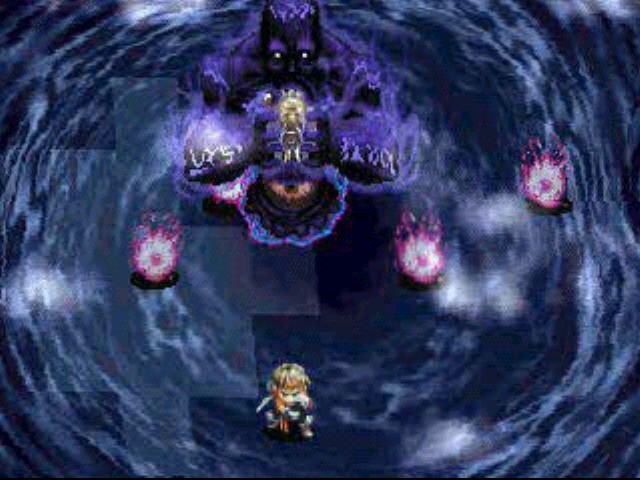Retro Replay Review
Gameplay
Arc the Lad blends traditional JRPG elements with a grid-based tactical system that was pioneering for its time. Rather than freely roaming a world map, you follow a tightly paced sequence of locations, each leading directly into story-driven encounters. When battles begin, you and your opponents occupy marked squares on a battlefield grid. Characters can move only a certain number of squares per turn, and positioning becomes just as crucial as attack strength or magic power.
(HEY YOU!! We hope you enjoy! We try not to run ads. So basically, this is a very expensive hobby running this site. Please consider joining us for updates, forums, and more. Network w/ us to make some cash or friends while retro gaming, and you can win some free retro games for posting. Okay, carry on 👍)
Each character has a unique movement range, attack pattern and magic or skill progression, which encourages you to think several moves ahead. Arc wields his sword in close quarters, while Kukuru’s healing and support spells prove indispensable for tough boss fights. Enemies vary from simple outlaws to powerful spirit guardians, and optional side battles let you grind experience or test new party formations. Strategic use of ranged attacks, area-of-effect spells and support abilities adds depth, ensuring no two fights feel completely alike.
Progression is steady but uncompromising: battles get challenging quickly, so you’ll need to manage your resources—items, MP and HP—with care. Items are limited, and the cost of resupplying can be steep, prompting thoughtful conservation or revisiting earlier battles to build up funds. Despite its linear structure, Arc the Lad rewards exploration of every battle scenario and thorough character development, making every victory feel earned.
Graphics
Visually, Arc the Lad sports charming, hand-drawn 2D sprites for both characters and enemies, set against richly colored backgrounds. Character portraits during dialogue scenes convey emotion effectively, with detailed pixel art capturing subtle expressions. Battlefields are rendered in a simple isometric grid, but varied terrain—stone floors, forest clearings, snowy plains—adds visual flavor to each encounter.
While the game’s visuals may seem dated by modern standards, they retain a nostalgic appeal reminiscent of late-’90s console JRPGs. Special attacks and magic spells trigger flashy animation sequences, complete with screen-filling effects. The sprite animations are smooth and punchy, reinforcing the impact of each blow or elemental spell. Cutscenes, though brief, utilize still images and text-based dialogue to advance the plot, letting you focus on the narrative without lengthy cinematic interruptions.
The user interface is clean and intuitive. Menus are logically organized: selecting characters, viewing stats, changing equipment and stocking up on items is straightforward. Battle menus clearly display each unit’s movement range and attack radius, preventing confusion in the heat of combat. Though there’s no voice acting, the simple menu clicks and sound effects provide enough feedback to keep you keyed into every decision.
Story
Arc the Lad opens in a village shackled by tradition. Kukuru, bound to marry a man she does not love, is talked into extinguishing an ancient flame that imprisons a powerful spirit. In an instant, the spirit is freed—and havoc begins. This inciting incident introduces the game’s central dilemma: should you preserve sacred customs at the cost of personal freedom, or defy them and risk unleashing catastrophe?
Enter Arc, a young adventurer whose father was slain by the same mysterious spirit now roaming free. He arrives in the burning village, determined to exact vengeance, only to discover that ancient forces are at play. As Arc and Kukuru team up, the narrative explores themes of destiny, sacrifice and personal honor. Their evolving relationship—initially defined by mutual distrust—grows into genuine camaraderie and purpose as they recruit allies and confront the spirit’s wrath.
The pacing balances action-driven cutscenes with quieter moments of character interaction. Subplots involving townsfolk, rogue mercenaries and hidden artifacts add depth to the journey. Though the script occasionally falls into familiar JRPG tropes—stoic mentor figures, ominous prophecies—the sincerity of the protagonists’ motivations keeps the stakes feeling real. By the time the final chapters unfold, you’ll be invested in both the fate of the world and the personal arcs of Arc and Kukuru.
Overall Experience
Arc the Lad remains a standout title for fans of tactical JRPGs, offering a blend of strategic combat and heartfelt storytelling. Its relatively short length—around 15–20 hours for a first playthrough—makes it an accessible introduction to the genre, while optional battles and unlockable equipment provide replay value. The learning curve is brisk, but once you grasp the importance of positioning and party synergy, each encounter becomes a satisfying puzzle to solve.
The game’s strengths lie in its focused narrative and tight gameplay loop: move to the battlefield, execute tactical skirmishes, unlock the next chapter, and repeat. There’s little downtime between objectives, so momentum carries you forward. Though modern gamers may miss an open world or more robust character customization, Arc the Lad’s streamlined approach ensures every minute feels meaningful.
For collectors and newcomers alike, Arc the Lad is a worthwhile journey through a charmingly crafted world of flame spirits and moral quandaries. Its enduring legacy has inspired sequels and remakes, but the original PS1 release holds a unique place in JRPG history. If you’re seeking a compact, strategy-infused role-playing experience with memorable characters and a driving narrative, this classic title still sparks excitement.
 Retro Replay Retro Replay gaming reviews, news, emulation, geek stuff and more!
Retro Replay Retro Replay gaming reviews, news, emulation, geek stuff and more!









Reviews
There are no reviews yet.